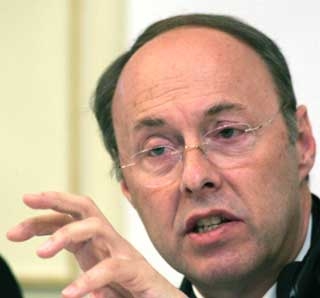
OMV JOINS WITH GAZPROM TO UNDERCUT NABUCCO
Publication: Eurasia Daily Monitor Volume: 5 Issue: 17
By:

On January 25 Austria’s state-dominated OMV energy company and Russia’s Gazprom signed an agreement to turn the Baumgarten gas transmission center near Vienna into a joint venture. Owned 100% by OMV until now, and ranked as the second- or third-largest gas transmission center in continental Europe, Baumgarten is the designated terminus of the EU’s Nabucco pipeline project for Caspian gas to Europe. Turning Baumgarten into a joint venture with Gazprom deprives Nabucco of its final outlet and preempts the market in Gazprom’s favor.
OMV’s CEO Wolfgang Ruttenstorfer and Gazprom vice president Alexander Medvedev signed the agreement in Vienna, with full backing from the Austrian government. Baumgarten is being turned into a 50%-50% OMV-Gazprom joint venture under the name Central European Gas Hub (CEGH). According to their press releases, the two companies plan to expand CEGH to become Europe’s number-one gas-trading hub. They intend to build underground storage sites for Gazprom gas near the CEGH in Austrian territory and “neighboring countries.” Baumgarten is located near the intersection of Austria’s borders with Hungary and Slovakia. The vague reference to sharing some business with those countries seems designed to play them off against each other, in line with Gazprom’s familiar tactics.
Baumgarten handled an estimated 16 to 18 billion cubic meters of mostly Russian gas in 2007, more than double the 2006 volume of 7.7 billion cubic meters. Gazprom is tempting Austria with the promise to use the CEGH for some 30% of Gazprom’s total gas exports to the EU already this year. The Baumgarten center currently has 46 registered customer companies, ranging from local and regional gas-trading and brokerage firms to Gazprom’s transnational subsidiaries such as the Berlin-based ZMB.
The agreement just signed stems from the OMV-Gazprom memorandum of understanding signed in May 2007 during Russian President Vladimir Putin’s visit to Austria. It was clear already at that point that turning Baumgarten into a joint venture with Gazprom would severely hurt Nabucco’s prospects (see EDM, May 29, 2007). Although the EU had declared Nabucco a top priority of its energy security policy, Brussels did nothing to stop Austria’s handover of Baumgarten or to propose instruments that would prevent such sabotage of the EU’s declared policies and priorities.
With sufficient forewarning since last May, Brussels failed again to react in November when Gazprom’s Alexander Medvedev and OMV’s CEGH managing director Harald Wuestrich announced that the negotiations were advancing (see EDM, November 19, 2007). OMV’s temptation to become a leading distributor of Russian-delivered gas in Europe seemed to trump the consideration of strategic consequences, which, in this case, would nip the Nabucco project in the bud.
OMV hoped that Gazprom would turn Baumgarten into Europe’s largest gas hub, to outrank the Belgian hub at Zeebrugge. At that same juncture, however, Gazprom was negotiating with the Nederland Gasunie to deliver gas through the planned Nord Stream project to the Netherlands (see EDM, November 9, 2007). And earlier in the year, Gazprom was luring Belgium with the promise to turn that country into a gas distribution hub. While Gazprom can not conceivably deliver on all these promises, some countries seem inclined to turn over parts of their infrastructure to Gazprom in anticipation of highly uncertain gas volumes, and break ranks with the EU in the process.
OMV’s move seems all the more surprising, given Gazprom’s intention to reduce substantially the volume of its gas exports through Ukraine, which is now the route for Russian gas reaching Central Europe. However, the Austrian government and OMV seem prepared to change the Nabucco project’s original purpose and use it for Russian-delivered gas. On January 21, OMV’s executive Reinhard Mitschek, who is the Nabucco project’s managing director, announced that Russian gas would be welcome into the Nabucco pipeline (UPI, January 21). And on January 24, Austrian Economics Minister Martin Bartenstein publicly suggested “integrating” Nabucco with Gazprom’s South Stream project and expressed satisfaction with Gazprom’s apparent willingness to pump Russian gas through such a pipeline (Die Presse, January 24).
Moscow is drawing closer to three major goals through the Baumgarten deal. First, preempting access to the Central European hub and market niches in favor of Russian-delivered gas, instead of Azerbaijani gas and other Caspian gas delivered directly. Second — as a consequence of the first — killing the Nabucco project or using it for Russian-delivered gas, mostly from Central Asia. And, third, creating a Russian-controlled arrangement in Europe, ostensibly modeled on the New York Mercantile Exchange (NYMEX), but using it to leverage market dominance into continuing acquisitions of infrastructure in Europe.
(Die Presse, Wirtschaftsblatt, Dow Jones, January 25, 26)




